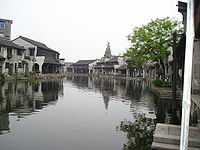
Nanxun District
Encyclopedia

Prefecture-level city
A prefectural level city , prefectural city or prefectural level municipality is an administrative division of the People's Republic of China, ranking below a province and above a county in China's administrative structure. Prefectural level cities form the second level of the administrative...
of Huzhou
Huzhou
Huzhou is a prefecture-level city in northern Zhejiang province of Eastern China. Lying south of the Lake Tai, it borders Jiaxing to the east, Hangzhou to the south, and the provinces of Anhui and Jiangsu to the west and north respectively.-Administration:...
, Zhejiang
Zhejiang
Zhejiang is an eastern coastal province of the People's Republic of China. The word Zhejiang was the old name of the Qiantang River, which passes through Hangzhou, the provincial capital...
province, China
China
Chinese civilization may refer to:* China for more general discussion of the country.* Chinese culture* Greater China, the transnational community of ethnic Chinese.* History of China* Sinosphere, the area historically affected by Chinese culture...
. Nanxun Town (南浔镇), an old town, is located in the district. It is one of the most well-preserved old towns in this region and is known for its cultural heritage. Other towns in the district include Shuanglin, Lianshi, Linghu, Shanlian
Shanlian
Shanlian is a small town located in northern Zhejiang province in China, in the Nanxun District of the Huzhou administrative district. This town is noted as being the sole source in the world for the highly prized Huzhou writing brush, which has been manufactured in the town for over 2,000...
, Qianjin and Shicong.
History
It was called Xunxi in the 9th century; Nanxun was established in the 13th century. The town turned into an important distribution center of farm and other products due to convenient transportation by water. Between the 16th to 19th centuries. The area emerged as one of the first entrepreneurial regions in the regions south of the Yangtze River. Production of silkworm and silk reels flourished and the raw silk trade developed. Naxun became a commodity economy situated between in Jiangsu and Zhejiang provinces.Site description
The ancient town looks like a cross when viewed from above, with an total area of 68 hectares. Two waterways intersect at the town, they are the Shihe River is from north to south, and that of the ancient Grand Canal from east to west.The town developed due to the to the waterways. The waterway became streets and houses were constructed beside the waterways. boats were used for transportation.
The waterways intersected within the town, which is surrounded by an outer ring of waterway. The traffic pattern of the ancient town has the land traffic parallel to the water traffic; the street is in front and the waterway in the rear. In the whole town, the waterways has a total length of 4.5 kilometers. There still remain 15 old bridges from the Song, Yuan, Ming and Qing Dynasties; the traditional flagging streets is 3 kilometers in total length. The houses were built on both sides of the waterways. The style and features of the traditional streets have been preserved. The layout remains that of imposing dwellings and spacious courtyards, gardens and library, guild hall and chamber of commerce, sotto porticos crossing the streets, landing terraces and covered ways. Many traditional houses and carved-brick arches over gateways still stand today. Of these structures from the Ming and Qing Dynasties, there are about 100,000 square meters in floor area, four of which have been registered as cultural heritage relics of Zhejiang province (Two of them have applied for being listed as national cultural conservation relics); nine are the cultural conservation units of Huzhou Municipality, and 20 are the cultural conservation relics of Nanxun Town, which was named the Famous Historic and Cultural Town by the People's Government of Zhejiang Province.

